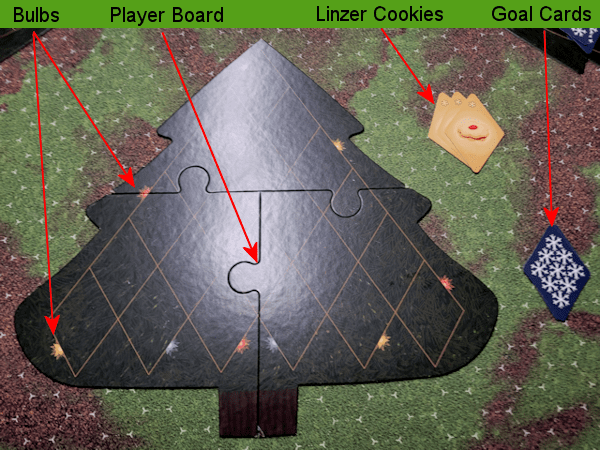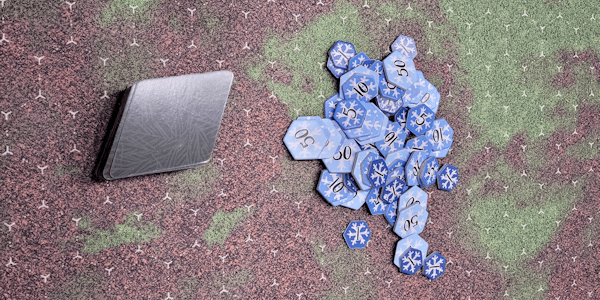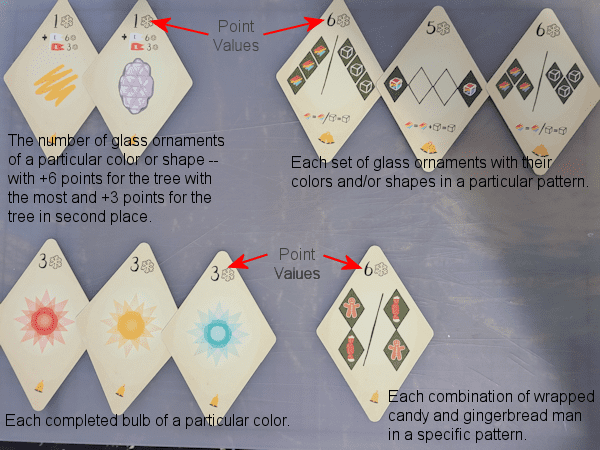Christmas Tree is one of those games that I had no idea existed. My friend, Steve, knows that my wife is a Christmas fanatic (e.g., she watches Hallmark-style Christmas movies year-round, parts of our house are decorated with Christmas lights that never come down, etc.). So a few years back, a bunch of people in my social group were doing a Secret Santa when he stumbled onto this game. He had drawn my wife’s name, so this was a no-brainer. My wife fell in love with this beautiful drafting game.

Game Play
Christmas Tree is a fairly straight-forward drafting game. Each player starts with a player board in the shape of a tree with 21 spaces allotted for decorations. Along the edges are halves of lights (bulbs, in the game’s vernacular) which can be used in scoring later. Players are also given three cards that show Linzer cookies, and three four goal cards (with snowflakes on the back) that they keep secret.

Next, the decorations deck is created. The deck has glass ornaments in three shapes (i.e., balls, stars, ovals) and three colors (i.e., blue, red, gold), wrapped candies, and a random selection of gingerbread men (three per player).

This deck is shuffled, the score markers (snowflakes) are put into the center of the table, and the game is ready to play!

The game is played in three rounds. In each round, the players are dealt eight cards from the decoration deck. Once they have a chance to look at the cards, they select one of the four goal cards they have and place it face-down in the middle of the table. Once all of the goals are in, they are turned over and form the scoring rules for that round. There are a variety of goals to work towards.

Each player chooses a card from their hand of decorations and places it face down on the table, and passes the rest of the cards to the left. Once all players have selected a decoration, they reveal them and place them into any open space on their tree. Decorations can be placed upside down if desired. Once everyone has placed seven decorations on their tree, the final card is discarded and the round is scored based on the goals that were selected.

The goals are then discarded, and a new round begins (i.e., each player is dealt eight decorations, selects one of their remaining goal cards for the round, and enters into a new draft).
At any time, a player may discard one of their Linzer cookies to adjust things on their tree. They can:
- Rotate a decoration (e.g., turn it upside down or upside right).
- Move a decoration to a new location on the tree.
- Swap two decorations on the tree.
Linzer cookies are great if you had to place a decoration in one place for scoring in a previous round, but need that decoration to be somewhere else for the current (or final) round.
After three rounds, each tree will be filled. Each player will have one goal card that was not used. This is when final scoring begins.
- Each glass ornament has 0, 1, or 2 snowflakes. Score 1 point per snowflake.
- Each wrapped candy has 3-6 snowflakes. Score 1 point per snowflake.
- Each decoration has 0-4 half-bulbs on the sides. Score 2 points per complete bulb (i.e., two halves of the same color).
- Score 1 point for each unused Linzer cookie.
- Then there are the gingerbread men…
Each gingerbread man has four symbols. These indicate the four possible adjacent spaces around the decoration. Gingerbread men score 2 points on their own, but this grows with each of the spaces around it that matches what it is looking for.

Add all that up and the player with the highest score wins. In case of a tie, there are no tie-breakers—the victory is shared (as the rulebook states: This is a Christmas game, after all).
Thoughts
Christmas Tree is a wonderful experience. The game is a delightful puzzle with a beautiful set of cards. Described above is the basic game. The rules also include a Family version that strips out some of the complexity for a younger audience. It also has an Advanced mode with cards that are added in that can make things a bit more challenging!
The patterns and how they can interact with the desire to complete bulbs is both challenging and satisfying. When to use the Linzer cookies (or to hold them back for bonus points) is interesting, but the fact remains: if you can score more than +1 point with the use of one, spend it. I am thinking that something more might have been needed here.
The need to match up with the round goals and the end-game scoring creates thinky moments as you try to balance things. This is a great game for anyone who loves Christmas.
If I had any complaints, it would be that the cards, given their size and shape, are exceedingly difficult to shuffle. I understand the need for the decoration cards to be like this, but the goal cards and the Linzer cookie cards have no need to be this awkward. For me, this is a very minor complaint. For someone with manual dexterity issues (e.g., arthritis), this might be a major stumbling block. I think that if these had been made thicker (such as a set of pieces that were punched from a board), then put into a bag to be drawn from, this might have worked better. The remaining cards that are not decorations should have been made larger, such as poker-sized cards or my favorite: the size used in 7 Wonders (65mm × 100mm).
All this said, the game itself is a holiday treat (that my wife wants to play all year long).












Add Comment